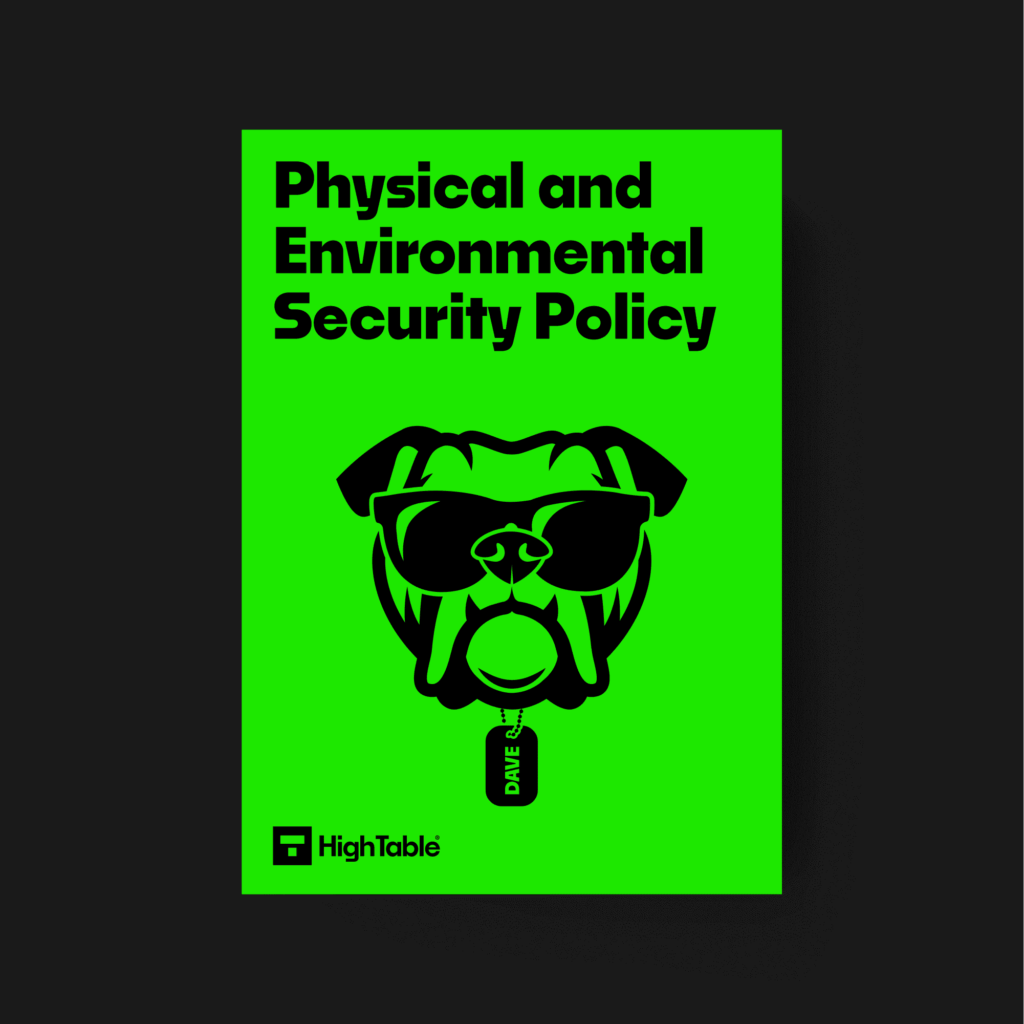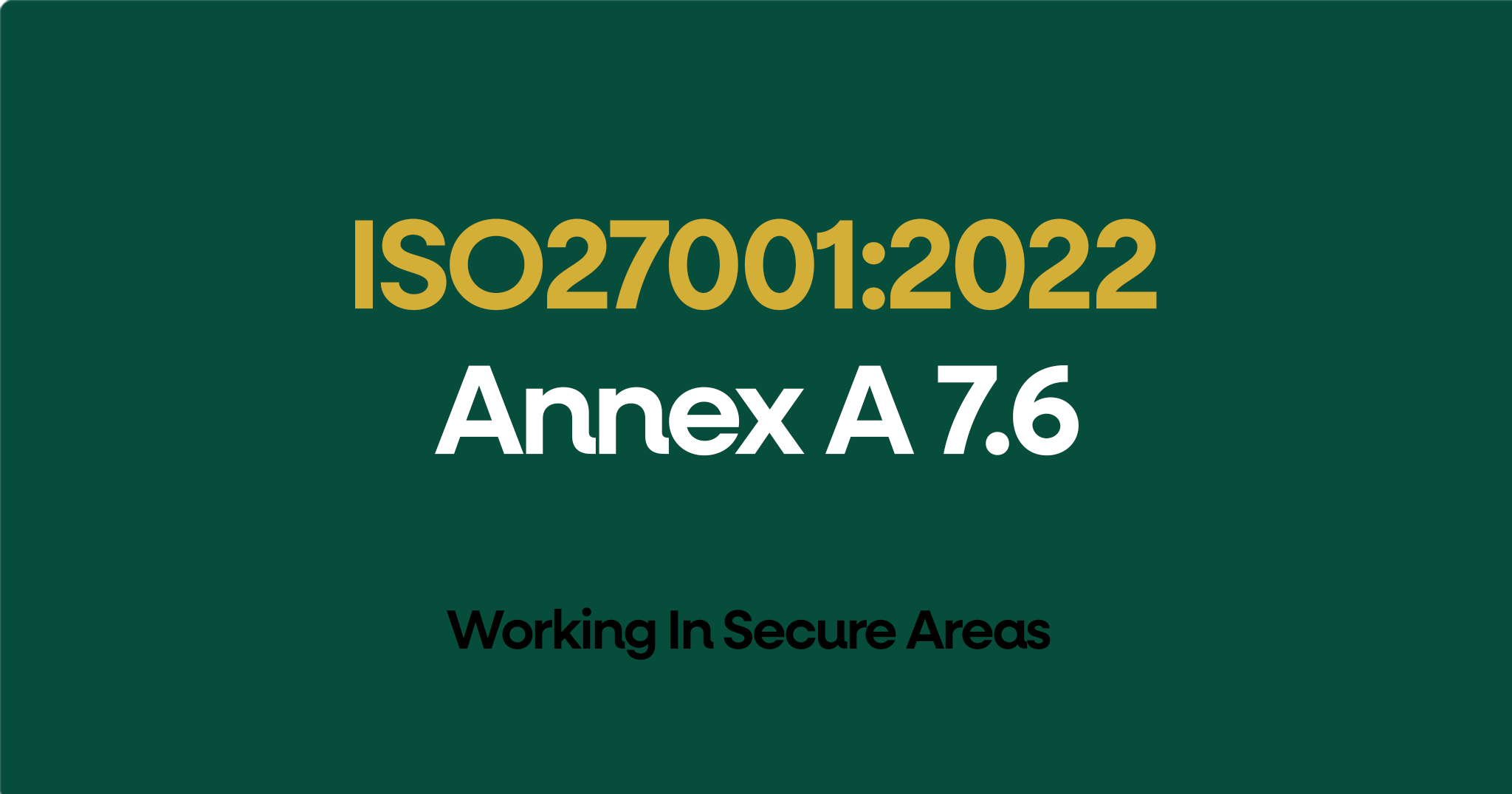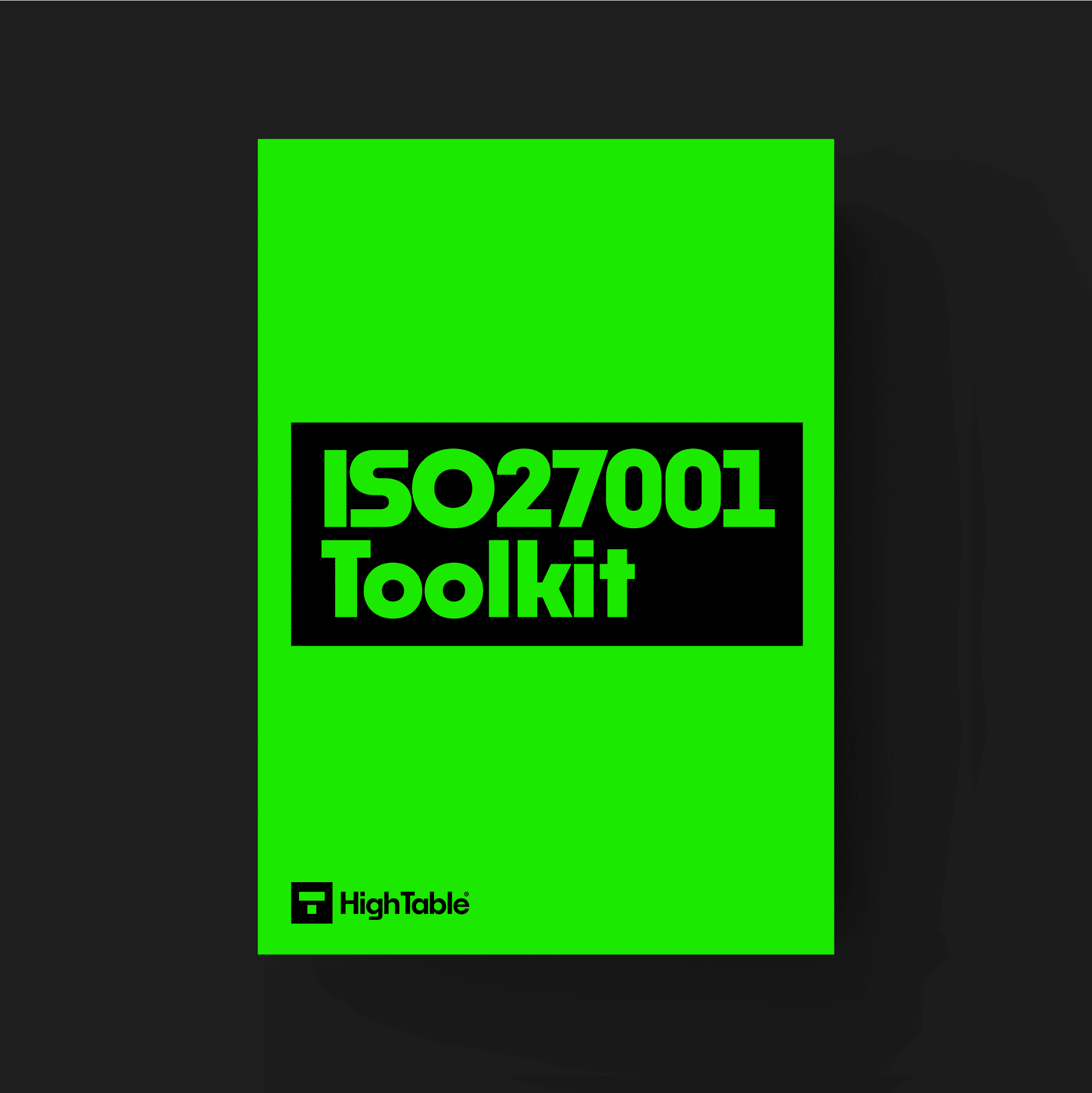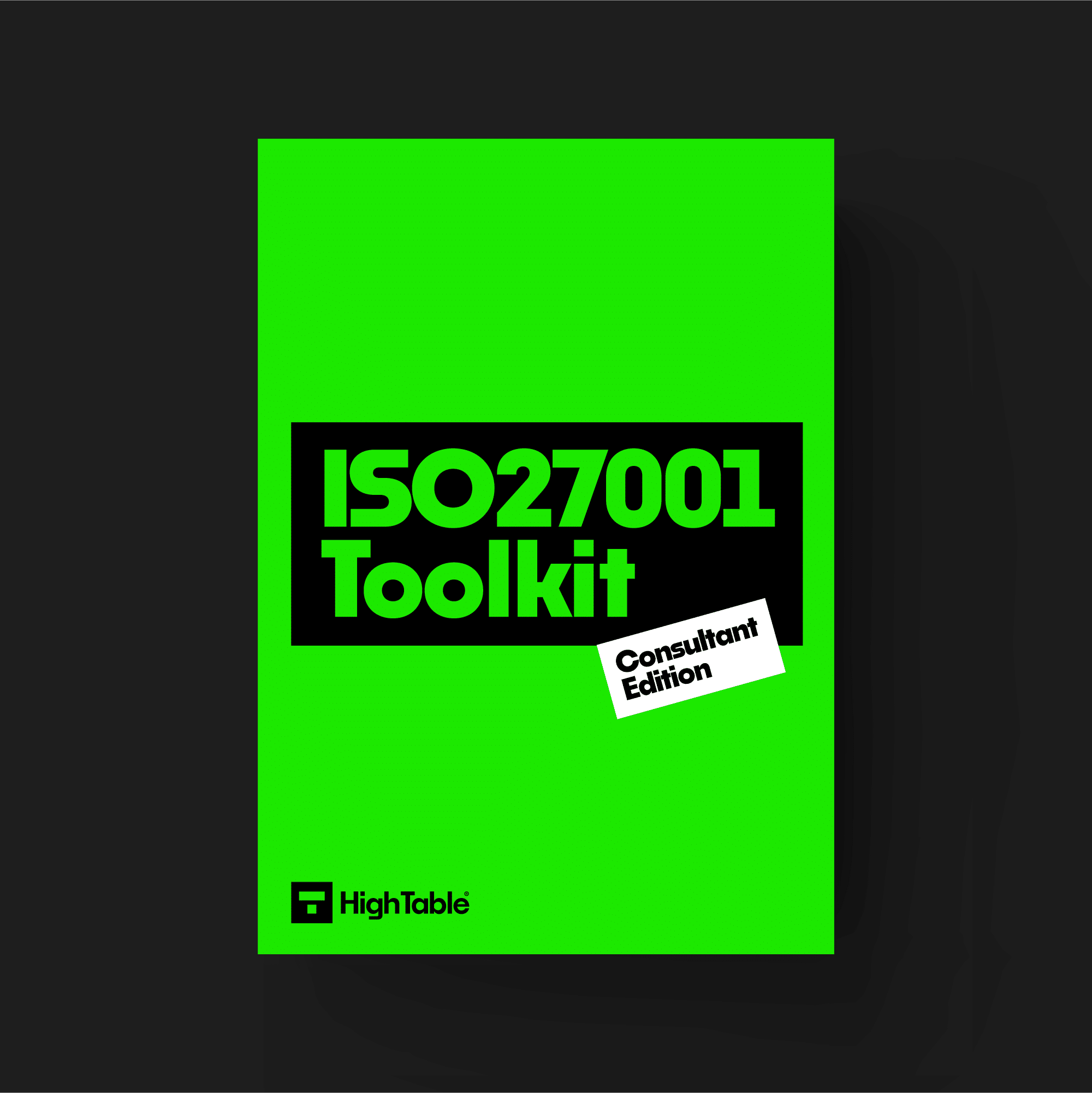ISO 27001 Working In Secure Areas
The focus for this ISO 27001 Control are your secure areas. As one of the ISO 27001 controls this is about stopping people who work in these secure areas from causing damage and unauthorised interference.
Table of contents
- ISO 27001 Working In Secure Areas
- What is ISO 27001 Annex A 7.6?
- Watch the ISO 27001 Annex A 7.6 Tutorial
- How to implement ISO 27001 Annex A 7.6
- Health and Safety
- ISO 27001 Physical Security Policy
- How to pass the audit
- What the auditor will check
- Top 3 Mistakes People Make
- ISO 27001 Annex A 7.6 FAQ
- Related ISO 27001 Controls
- Further Reading
- ISO 27001 Annex A 7.6 Attribute Table
What is ISO 27001 Annex A 7.6?
ISO 27001 Annex A 7.6 Working In Secure Areas is an ISO 27001 control that requires an organisation to put measures in place for security when working in secure areas.
ISO 27001 Annex A 7.6 Purpose
ISO 27001 Annex A 7.6 is a preventive control that ensures you protect information and other associated assets in secure areas from damage and unauthorised interference by personnel working in these areas.
ISO 27001 Annex A 7.6 Definition
The ISO 27001 standard defines ISO 27001 Annex A 7.6 as:
Security measures for working in secure areas should be designed and implemented.
ISO27001:2022 Annex A 7.6 Working In Secure Areas
Watch the ISO 27001 Annex A 7.6 Tutorial
In the video ISO 27001 Working In Secure Areas Explained – ISO27001:2022 Annex A 7.6 I show you how to implement it and how to pass the audit.
How to implement ISO 27001 Annex A 7.6
You are going to have to
- Implement a need to know approach to the existence, operation and working processes of secure areas
- Where practicable ensure that work in secure areas is supervised
- Put in a process of locking and inspecting vacant secure areas
- Consider preventing the use of cameras, phones, recording equipment unless you authorise it
- Train people in emergency procedures
- Communicate emergency procedures
- Follow all health and safety laws as well as all laws and regulations
The implementation of working in secure areas is in the context of the physical security perimeter where you can find guidance in the Ultimate guide to ISO 27001 Annex A 7.1 Physical Security Perimeter.
Health and Safety
Your number one priority is to meet the requirements of law and regulation. Be sure to engage with a legal professional to understand what you can and cannot do and to check that you are not breaking any laws. The most significant laws are those around health and safety as the protection of human life and wellbeing is always our number priority. There are common things that should be considered such as entry point doors that fail open. Whilst we want to protect buildings and information our absolute priority is to protect people.
ISO 27001 Physical Security Policy
To communicate to people what you do and what is expected you are going to write, sign off, implement and communicate your topic specific Physical and Environmental Security Policy.

How to pass the audit
To pass the audit of ISO 27001 Annex A 7.6 you are going to
- Define your physical protection requirements
- Consult with a legal professional to ensure you are meeting legal and regulatory requirements
- Consult with appropriate professionals who specialise in the identified protection requirements
- Implement your physical threat protection
- Write, sign off, implement and communicate your topic specific Physical and Environmental Security Policy
- Write, sign off, implement and communicate your secure working procedures
- Implement a process of internal audit that checks that the appropriate controls are in place and effective and where they are not follow the continual improvement process to address the risks
What the auditor will check
The audit is going to check a number of areas. Lets go through them
1. That you have defined secure working areas
Not every business or organisation requires secure areas but if you do the audit will check that you have defined what they are, done a risk assessment and put in place the appropriate controls and processes.
2. The you have implemented controls
They have been doing this a long time and done many audits so they know what to look for. They will test the controls and see what happens where they can. They will want to see evidence that the controls have been reviewed and tested and are working as intended.
3. Documentation
They are going to look at audit trails and all your documentation. They will look at appropriate maintenance, reviews, logs of monitors and reports, incidents and how you managed them.
Top 3 Mistakes People Make
The top 3 mistakes people make for ISO 27001 Annex A 7.6 are
1. Your fire extinguishers are not up to date
This one feels a bit random but as they walk around they will check fire extinguishers and look for evidence that they are operational and maintained. An example would be a fire extinguisher that works on pressure and the pressure gauge is at zero or in the red. Also that there is no evidence of them being maintained.
2. One or more members of your team haven’t done what they should have done
Prior to the audit check that all members of the team have done what they should have. Have control reviews taken place? Who gets informed about about the alarms and notification and do they still work here? Have you done periodic checks of vacant secure areas.
3. Your document and version control is wrong
Keeping your document version control up to date, making sure that version numbers match where used, having a review evidenced in the last 12 months, having documents that have no comments in are all good practices.
ISO 27001 Annex A 7.6 FAQ
Secure areas are usually where the most confidential work takes place, the most confidential data is processed and the most valuable assets are kept. They operate like a safe in a building. The ultimate line of physical defence. Getting this wrong can pose a significant risk to the organisation and its operation with the most likely result a data breach or loss of high value asset. The worst case scenario is that if this does occur that you do not know about it.
You will need the ISO 27001 Physical and Environmental Security Policy
There are templates that support ISO 27001 Annex A 7.6 located in the ISO 27001 toolkit
If you have a physical location, office or processing facility, then yes.
Yes. You can write the policies for IS27001 Annex A 7.6 yourself. You will need a copy of the standard and approximately 8 hours to do it. It would be advantageous to have a background n information security management systems. Alternatively you can download them the ISO 27001 Physical and Environmental Security Policy
The main template you need is the Physical and Environmental Security Policy
IS27001 Annex A 7.6 is not particularly hard as it is mainly common sense. As long as you consult with a legal professional on what you are doing to ensure you are not break any laws or regulations you will be fine. Physical security has been around a long time.
To write the Physical and Environmental Security Policy will take about 8 hours. To implement the controls will depend on what you re doing and what you are implementing. It can take from a few hours to a few months depending on how many locations you have and the level of security that you are implementing.
The Physical and Environmental Security Policy will cost you 8 hours to write yourself or less than £10 to buy. The cost to implement the controls will depend on what controls you implement and where you buy them.
Related ISO 27001 Controls
ISO 27001 Annex A 7.4 Physical Security Monitoring
ISO 27001 Annex A 7.5 Protecting Against Physical and Environmental Threats
Further Reading
ISO 27001 Physical Asset Register Beginner’s Guide
ISO 27001 Secure Development Policy Template
ISO 27001 Annex A 7.6 Attribute Table
| Control type | Information security properties | Cybersecurity concepts | Operational capabilities | Security domains |
|---|---|---|---|---|
| Preventive | Confidentiality | Protect | Physical security | Protection |
| Integrity | ||||
| Availability |
About the author
Stuart Barker is a veteran practitioner with over 30 years of experience in systems security and risk management.
Holding an MSc in Software and Systems Security, Stuart combines academic rigor with extensive operational experience. His background includes over a decade leading Data Governance for General Electric (GE) across Europe, as well as founding and exiting a successful cyber security consultancy.
As a qualified ISO 27001 Lead Auditor and Lead Implementer, Stuart possesses distinct insight into the specific evidence standards required by certification bodies. He has successfully guided hundreds of organizations – from high-growth technology startups to enterprise financial institutions – through the audit lifecycle.
His toolkits represents the distillation of that field experience into a standardised framework. They move beyond theoretical compliance, providing a pragmatic, auditor-verified methodology designed to satisfy ISO/IEC 27001:2022 while minimising operational friction.



